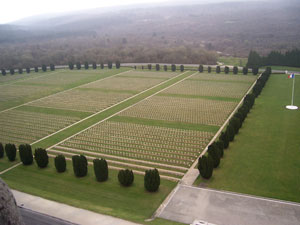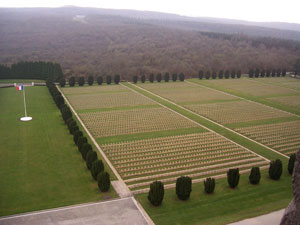
WWII: Maginot Line | Normandy | V-Weapon Sites | Arnhem
Further afield: Crete
| Home Tracing Military Ancestors Travel Advice CWGC Cemeteries Iron Harvest News Book Reviews Glossary Links Contact Me Verdun:
 
|
Location 12 – The Ossuary and National Cemetery
Brief History - French Counter-Offensives and Aftermath Directions – Following your visit to Abri des Quartre Cheminée walk back to the main road and continue right. This will, in 25 minutes or so, lead you back to the Ossuary and National Cemetery. Practical Information – The Ossuary is open every day, although has shorter opening hours during the winter months.
Historical Notes – The Ossuary was begun in 1920 and completed in 1932. A committee - the inspiration of the Bishop of Verdun, collected money for its construction. Each city that contributed has their coat of arms carved on the exterior masonry. For those familiar with the serried ranks of names of the missing on British war memorials at Ypres and on the Somme, the centre of French remembrance at Verdun, the Ossuary, may come as a disturbing and some would say, macabre, departure. Beneath the main building which contains a cloister and chapel, are 38 tombs stacked with the bones of 130,000 French and German soldiers killed during the battle and who have no known grave. These remains were unearthed as the battlefield was being cleared after the war and are grouped into the areas where they were found. Although so great were they in number that two overflow tombs were built at either end of the Ossuary. Visitors can glimpse these grisly relics of the fighting through tiny windows at the rear of the building. In front is the National Cemetery containing the graves of a further 15,000 identified French soldiers.
|
||||||


